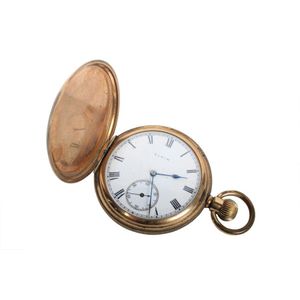E.J. Dent 18ct Half Hunter Pocket Chronometer
E J Dent, gold half hunter keyless pocket Chronometer, 18ct yellow gold, white Roman numeral dial, subsidary seconds at 9 O'clock, movement signed 'E J Dent, Watchmaker to the Queen, London', case and movement numbered 18325, case stamped with casemakers mark 'AN4 Adolphe Nicole' and London date letter 1852. Weight 81 grams, diameter 44 mm
You must be a subscriber, and be logged in to view price and dealer details.
Subscribe Now to view actual auction price for this item
When you subscribe, you have the option of setting the currency in which to display prices to $Au, $US, $NZ or Stg.
This item has been sold, and the description, image and price are for reference purposes only.
- Hunter - A hunter pocket watch is the type where the case includes a spring-hinged circular metal lid or cover, that closes over the glass face of the watch, protecting it from dust, scratches and other damage or debris. The majority of antique and vintage hunter-case watches have the lid-hinges at the 9 o?clock position, suiting the right handed user.
- Date Aperture - A date aperture is a cut out section in the face of a watch or clock, displaying the day of the month.
- Movement - The technical name for the workings of a clock or watch, and does not include the dial or case.
- Half Hunter - A half-hunter (or "demi hunter") pocket watch is one in which the outer lid over the face of the watch has a cut out centre section, enabling the owner to view the hands to tell the time, without having to open the lid. On some half-hunter watches, the hours are marked on the outer lid.
- Keyless Watch - A keyless watch is a type of pocket watch or wristwatch that does not require a separate winding key to wind or set the time. Instead, a keyless watch is wound and set by a small knob or button located on the side of the watch, called a crown.
Keyless watches were first introduced in the late 19th century and quickly became popular due to their convenience and ease of use. Prior to the development of keyless watches, pocket watches were typically wound and set using a small key that was inserted into a hole in the watch case. The key would be turned to wind the watch's mainspring, and then turned again to set the time.
With the introduction of the keyless watch, watchmakers were able to simplify the winding and setting process by eliminating the need for a separate key. Instead, the crown on the side of the watch could be pulled out to set the time, and then pushed back in to wind the watch's mainspring.
The keyless watch design has since become the standard for most modern watches, both pocket and wristwatches. In addition to being more convenient to use, keyless watches are also typically more reliable and accurate than earlier models that used winding keys.
This item has been included into following indexes:
Visually similar items

Pocket watch, Elgin, gold plated
Sold by
in
for
You can display prices in $Au, $US, $NZ or Stg.

Pocket watch: gentleman's 9ct gold crown wind hunter pocket watch. 48 mm.
Sold by
in
for
You can display prices in $Au, $US, $NZ or Stg.

Pocket watch, Waltham, gold plated
Sold by
in
for
You can display prices in $Au, $US, $NZ or Stg.

Of Australian Historical Interest: A Victorian enamel and gold cased keyless pocket watch, circa 1890, the case set with a central rose-cut diamond, surrounded by blue and turquoise enamel and a band of pink roses of a finely chased ground, opening to reve
Sold by
in
for
You can display prices in $Au, $US, $NZ or Stg.
